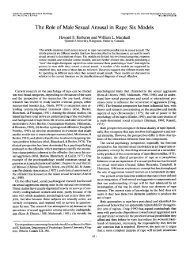Regulation of the dopamine transporter - Addiction Research ...
Regulation of the dopamine transporter - Addiction Research ...
Regulation of the dopamine transporter - Addiction Research ...
You also want an ePaper? Increase the reach of your titles
YUMPU automatically turns print PDFs into web optimized ePapers that Google loves.
DAT <strong>Regulation</strong> Schmitt & Reith<br />
many cytoplasmic-facing consensus sites for phosphorylation,<br />
many <strong>of</strong> which lie on <strong>the</strong> N terminus<br />
<strong>of</strong> <strong>the</strong> DAT protein (for a review <strong>of</strong> functional<br />
moieties in <strong>the</strong> DAT amino acid sequence,<br />
see Volz and Schenk 2 ). Protein phosphorylation is a<br />
de facto posttranslational strategy for regulating protein<br />
function, altering protein–protein interactions<br />
and transducing exogenous stimuli. Because phosphorylation<br />
<strong>of</strong> a particular residue in a protein can<br />
both drastically change its three-dimensional shape<br />
and serve as a signaling marker, is not surprising that<br />
<strong>the</strong> phosphorylation state <strong>of</strong> <strong>the</strong> DAT has a pr<strong>of</strong>ound<br />
influence on both <strong>the</strong> intrinsic activity (i.e., affinity<br />
for and responsiveness to various ligands) and membrane<br />
distribution <strong>of</strong> <strong>the</strong> <strong>transporter</strong>. 4 Several protein<br />
kinases and phosphatases involved in key signaling<br />
cascades can affect DAT function, including<br />
members <strong>of</strong> <strong>the</strong> protein kinase C (PKC), protein kinase<br />
A, phosphatidylinositol-3-kinase (PI3K), protein<br />
tyrosine kinase, Ca 2+ /calmodulin kinase, protein<br />
phosphatase 1, and mitogen-activated protein<br />
kinase (MAPK) families. 49–52 Of <strong>the</strong>se, PKC has been<br />
<strong>the</strong> most thoroughly investigated; however, a direct<br />
phosphotransferase reaction between PKC and <strong>the</strong><br />
DAT has not been demonstrated, suggesting that<br />
o<strong>the</strong>r (currently undefined) downstream kinases<br />
may be responsible for <strong>the</strong> direct phosphorylation<br />
<strong>of</strong> <strong>the</strong> DAT. 4,51 In addition to possible direct effects<br />
on <strong>the</strong> DAT and on DAT membrane trafficking, activation<br />
(or, by <strong>the</strong> same token, inhibition) <strong>of</strong> <strong>the</strong>se<br />
phosphorylation pathways can affect <strong>the</strong> regulatory<br />
and transmitter-releasing action <strong>of</strong> substrates, such<br />
as amphetamine. As we discuss in <strong>the</strong> following,<br />
both substrate exposure and PKC activation can<br />
result in DAT downregulation; however, despite a<br />
myriad <strong>of</strong> studies demonstrating <strong>the</strong> importance<br />
<strong>of</strong> protein kinases and phosphatases in substratemediated<br />
regulation <strong>of</strong> plasmalemmal DAT expression,<br />
explicit details regarding <strong>the</strong> mechanistic link<br />
between <strong>the</strong> two processes have been elusive. 50 In<br />
contrast with substrates, classical DAT inhibitors,<br />
such as cocaine, �-CFT, and methylphenidate, have<br />
little effect on DAT phosphorylation. 48<br />
Protein kinase C<br />
Functional regulation <strong>of</strong> <strong>the</strong> DAT in response to<br />
PKC activation was first demonstrated in vitro by<br />
using phorbol-ester kinase modulators, such as 4�phorbol-12-myristate-13-acetate<br />
(�-PMA). Incubation<br />
with �-PMA (or o<strong>the</strong>r nonphorbol PKC<br />
activators) dramatically increases levels <strong>of</strong> 32 PO4labeled<br />
immunoprecipitated DAT in both synaptosomes<br />
53 and cells heterologously expressing DAT. 54<br />
Increased phosphorylation was not observed in<br />
<strong>the</strong> presence <strong>of</strong> <strong>the</strong> inactive phorbol analogue 4�phorbol-12,13-didecanoate,<br />
and all effects <strong>of</strong> �-<br />
PMA were abolished by cotreatment with <strong>the</strong> PKC<br />
inhibitor bisindoylmaleimide I, highlighting <strong>the</strong> involvement<br />
<strong>of</strong> PKC. 53 Analogous to <strong>the</strong> findings with<br />
DAT substrates, pretreatment with PKC activators<br />
acutely and rapidly reduces [ 3 H]<strong>dopamine</strong> uptake<br />
by lowering <strong>the</strong> V max for uptake without affecting<br />
<strong>the</strong> Km valueandreduces<strong>the</strong>Bmax <strong>of</strong> [ 3 H]mazindol<br />
binding to intact Xenopus oocytes, 55 suggesting a<br />
role for phosphorylation in promoting <strong>the</strong> internalization<br />
<strong>of</strong> plasmalemmal DAT. A follow-up study by<br />
Melikian and Buckley substantiated this hypo<strong>the</strong>sis:<br />
<strong>the</strong> authors found that induction <strong>of</strong> PKC with<br />
�-PMA results in intracellular redistribution <strong>of</strong> <strong>the</strong><br />
DAT from <strong>the</strong> plasma membrane to recycling endosomal<br />
compartments in hDAT-expressing PC12<br />
cells. 56 Endocytic trafficking <strong>of</strong> <strong>the</strong> DAT to early<br />
and recycling endosomes in response to PKC activation<br />
has since been demonstrated in many different<br />
cell models and has been visualized in live cells,<br />
using various fluorescent-tagged DATs. 25,57 PKCmediated<br />
loss <strong>of</strong> plasmalemmal DAT is probably due<br />
to a combination <strong>of</strong> increased clathrin-dependent<br />
endocytosis and decreased recycling from endosomal<br />
compartments. 58 Proteolytic digestion studies<br />
<strong>of</strong> 32 PO4-labeled DAT indicate that serine residues<br />
in <strong>the</strong> N terminus are major target sites <strong>of</strong> phosphorylation<br />
after exogenous pharmacological PKC activation.<br />
59 In both constitutive and PKC-mediated<br />
DAT internalization, an endocytic motif has been<br />
shown to be required in <strong>the</strong> DAT C terminus, that<br />
is, residues 587–596; <strong>the</strong> results do not rule out <strong>the</strong><br />
possibility that o<strong>the</strong>r DAT sequences play a role in<br />
<strong>the</strong> interaction between <strong>the</strong> <strong>transporter</strong> and <strong>the</strong> endocytic<br />
machinery, with such sequences being sensitive<br />
to <strong>the</strong> local environment within <strong>the</strong> 587–596<br />
motif. 60 Essential elements <strong>of</strong> <strong>the</strong> DAT C-terminal<br />
endocytic motif are conserved within <strong>the</strong> SLC6<br />
<strong>transporter</strong> family but not in any o<strong>the</strong>r protein, indicating<br />
that DAT endocytosis may involve a clathrinindependent<br />
component. 60 Recent studies by <strong>the</strong><br />
group <strong>of</strong> Vaughan 61 does not indicate clathrinindependent<br />
endocytosis <strong>of</strong> DAT, but <strong>the</strong>y do<br />
suggest a role for cholesterol-sensitive raftassociated<br />
DAT that responds to PKC with reduced<br />
322 Ann. N.Y. Acad. Sci. 1187 (2010) 316–340 c○ 2010 New York Academy <strong>of</strong> Sciences.










